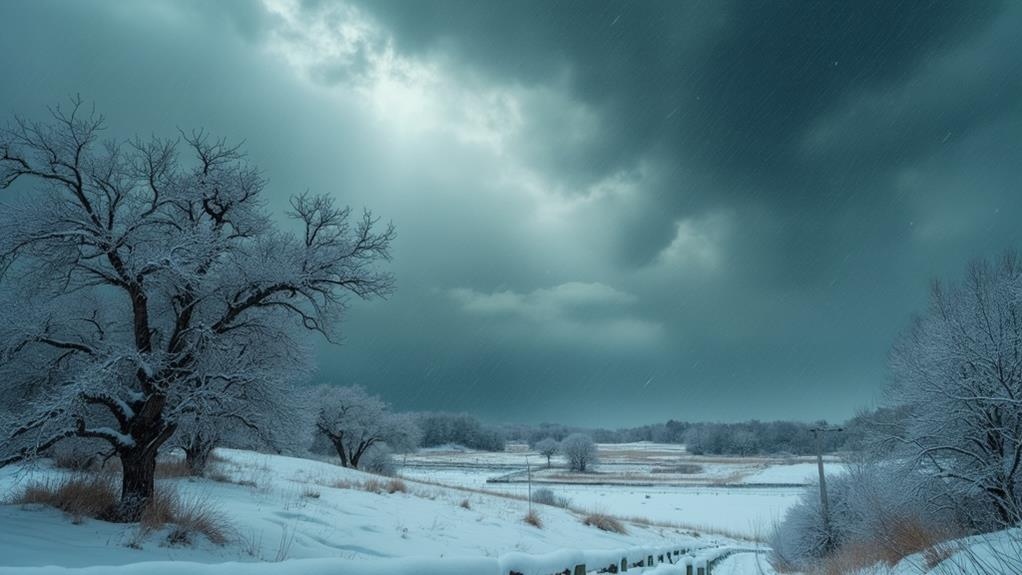The Texas Winter Storm of 2021

Do you remember the Texas Winter Storm of 2021? The Arctic cold front transformed the state into a frozen landscape, causing unprecedented power outages and a tragic loss of life. Nearly 10 million residents were left without power, struggling with record low temperatures. What really happened to Texas' power grid, and could it have been prevented? Reflecting on these questions highlights the broader implications for emergency preparedness and infrastructure resilience. What lessons did we learn, and what steps are being taken to ensure it never happens again?
Meteorological Background

How did a typical winter storm turn into a historic event? The Texas Winter Storm of 2021 was triggered by a strongly negative Arctic Oscillation (AO), which allowed an Arctic cold front to penetrate deep into mid-latitudes. This severe winter storm originated in the Pacific Northwest and swept across the Southern United States, causing drastic temperature drops and widespread disruptions.
The impact of the storm was exacerbated by a weakened jet stream, which failed to contain the Arctic air. Consequently, temperatures plummeted to record lows, with some areas experiencing a bone-chilling -30°F (-34.44°C). Such extreme cold transformed a routine winter storm into a weather disaster of historic proportions.
The National Weather Service issued numerous winter weather alerts, affecting over 170 million Americans. Among them, approximately 9.9 million people in Texas bore the brunt of the severe conditions. The storm's lowest atmospheric pressure was recorded at 960 mbar (28.35 inHg), underscoring its intensity as a major winter weather event.
Understanding this meteorological background highlights how a combination of atmospheric phenomena can escalate a typical winter storm into an unprecedented weather disaster.
Timeline of Events
The Texas Winter Storm of 2021 unfolded within a complex meteorological context. The initial cold front arrived on February 10, sharply lowering temperatures and triggering winter weather alerts. By February 11, a Winter Weather Advisory was issued for northwest Texas. The storm intensified as a powerful Arctic cold front swept through the region by February 14.
From February 13 to February 16, Houston was under a Winter Storm Warning as freezing temperatures persisted. Snow and ice accumulated rapidly, with Brazos County reporting up to 6 inches of snow. Severe ice buildup across multiple counties led to hazardous conditions and widespread power outages.
The Great Freeze, spanning nearly nine days, concluded with the last Hard Freeze Warning expiring on February 20. Throughout this period, Texans endured relentless freezing temperatures and treacherous snow and ice. The storm's prolonged duration and severity left a lasting impact on the state.
Power and Infrastructure Failures

The prolonged power outages during the 2021 winter storm affected nearly 10 million Texans, revealing major vulnerabilities in the state's grid. The extreme cold led to significant infrastructure failures, including burst water pipes and boil water advisories. These events underscored the urgent need for infrastructure improvements to better withstand severe weather in the future.
Prolonged Power Outages
During the 2021 winter storm, millions of Texans endured prolonged power outages as the state's unprepared power infrastructure succumbed to severe icy conditions. Nearly 10 million residents struggled to stay warm without electricity for several days, with over 4.5 million households losing power at the peak. The extreme cold temperatures exacerbated the situation as people faced the crisis with no heat. This event underscored the fragility of Texas's power grid, which was not adequately prepared for such severe winter weather.
Key challenges experienced during this catastrophic event included:
- Extended Power Outages: Many homes went without electricity for days, making it difficult to maintain warmth.
- Infrastructure Failures: Freezing temperatures caused pipes to burst and water systems to fail, adding to the hardships.
- Overwhelmed Emergency Services: Emergency calls surged as people faced heating and safety issues, straining already stressed resources.
- Significant Damages: The storm resulted in around $1 billion in damages, highlighting the need for more resilient infrastructure.
This crisis highlighted the urgent need for winterizing power systems and improving infrastructure to better prepare for future severe weather events. The prolonged power outages served as a wake-up call for future preparedness.
Grid Vulnerabilities Exposed
During the 2021 Texas Winter Storm, vulnerabilities in the state's power and infrastructure systems were starkly exposed. Nearly 10 million Texas residents faced widespread power outages as the power grid failed under the frigid temperatures. At the peak of the storm, approximately 4.5 million households lost electricity, leaving many without power for several days. This was due to infrastructure failures and issues with generation capacity.
The Electric Reliability Council of Texas (ERCOT) reported over 46,000 megawatts of generation capacity offline, primarily because of frozen wind turbines and natural gas supply disruptions. These failures revealed significant gaps in the state's emergency response protocols. Delayed power restoration efforts and inadequate infrastructure resilience meant Texas residents suffered prolonged outages and extreme discomfort.
The financial toll on Texas's power infrastructure is estimated to be around $1 billion. This figure underscores the urgent need for long-term investments to bolster grid reliability. The storm's aftermath made it clear that the existing systems couldn't handle extreme weather events like severe winter storms, highlighting the critical need to address these vulnerabilities for future resiliency.
Infrastructure Improvements Needed
The 2021 Texas Winter Storm underscored the urgent need for comprehensive infrastructure improvements to avoid future power and system failures. The storm demonstrated how weather-related events could incapacitate a state's power grid, affecting nearly 10 million residents. This incident highlighted not just the issue of power outages but also the necessity for bolstering emergency response and infrastructure resilience.
Key areas for improvement include:
- Grid Modernization: Upgrading the electric grid with advanced technology to withstand extreme weather conditions and prevent widespread outages.
- Emergency Response Systems: Enhancing coordination and resources for emergency responders to save lives and mitigate crisis impacts.
- Environmental Protections: Strengthening infrastructure to safeguard local ecosystems and prevent events like the loss of nearly 3.8 million fish along the Texas coast.
- Durable Construction: Investing in resilient infrastructure to reduce damage, which amounted to an estimated one billion dollars during the storm.
Local governments are already prioritizing these areas, learning from past experiences to better prepare for future extreme weather events. Addressing these critical points will help ensure that Texas is equipped to handle any severe weather challenges ahead.
Emergency Response
The Texas Winter Storm of 2021 brought unprecedented cold and ice, severely challenging emergency response efforts. The extreme weather conditions and high volume of incidents overwhelmed emergency services, with delayed 911 responses highlighting critical gaps in protocols.
Local authorities quickly activated emergency measures, advising residents to stay indoors and avoid travel due to hazardous conditions. Despite these efforts, the storm exposed significant vulnerabilities in Texas's preparedness for extreme winter weather. The high demand for assistance emphasized the need for more robust infrastructure and comprehensive pre-storm planning.
Shelters were opened to provide warmth and safety for those without heat or power, showcasing a coordinated effort among state and federal agencies to mitigate the crisis. However, the situation has prompted a reevaluation of current emergency response plans. Moving forward, Texas must focus on improving infrastructure resilience and enhancing community preparedness to better handle future storms. This incident serves as a critical learning experience for refining emergency protocols and readiness.
Human and Wildlife Impact

The tragic loss of over 200 lives and the significant emotional and financial toll on millions of Texans cannot be overlooked. Wildlife rescue initiatives became essential as approximately 3.8 million fish perished, and sea turtles suffered from cold stunning. The long-term environmental effects on local ecosystems are concerning, raising questions about their resilience.
Tragic Human Casualties
The Texas Winter Storm of 2021 had a devastating impact on human and wildlife populations. Tragically, the death toll exceeded 200 people. Many of these deaths were due to hypothermia as residents struggled to stay warm in the severe weather. Carbon monoxide poisoning also claimed lives, as individuals used unsafe methods to heat their homes. Hazardous road conditions further exacerbated the situation, leading to fatal traffic accidents.
Consider the following points to understand the full scope of the human tragedy:
- Hypothermia: Many homes lost heating, exposing residents to dangerously low temperatures.
- Carbon Monoxide Poisoning: In their desperation for warmth, people used generators and grills indoors, resulting in deadly fumes.
- Traffic Accidents: Icy roads and poor visibility led to numerous fatal crashes.
- Emergency Services: Overwhelmed by broken water pipes and other crises, emergency services could not reach everyone in need.
Beyond the immediate loss of life, the emotional and financial toll on residents was profound. Widespread property damage, prolonged power outages, and the severe weather left many Texans in distress, struggling to recover from the storm's aftermath.
Wildlife Rescue Initiatives
The Texas Winter Storm of 2021 had devastating effects on both human and wildlife populations. Cold-stunned sea turtles were unable to migrate due to the extreme cold, necessitating urgent wildlife rescue operations. The Texas Parks and Wildlife Department reported that approximately 3.8 million fish, representing over 60 species, died along the coast. These losses highlight significant ecological damage that will take years to recover from.
In response, agencies quickly mobilized to mitigate the damage. Rehabilitation centers were established to treat affected species, and monitoring programs were initiated to assess the freeze's impact. These efforts are crucial for improving response strategies for future climate-related disasters.
Wildlife Rescue Initiatives:
| Impacted Species | Rescue Initiatives |
|---|---|
| Sea Turtles | Cold-stun rescue and rehabilitation centers |
| Fish (60+ species) | Population monitoring and recovery efforts |
| Terrestrial Wildlife | Habitat assessment and support |
| Marine Ecosystems | Long-term ecological studies |
The storm's impact has led to discussions about enhancing these initiatives. The dedication and swift actions taken to protect and rehabilitate Texas's wildlife demonstrate a commitment to ensuring their survival during harsh climate-related events.
Long-term Environmental Effects
The Texas Winter Storm of 2021 left a lasting impact on both human and wildlife populations, with long-term environmental effects that are still unfolding. The frigid temperatures resulted in widespread deaths among marine and terrestrial species, highlighting significant ecological concerns.
Key impacts include:
- Fish Loss: Approximately 3.8 million fish along the Texas coast perished, affecting over 60 species. Recovery of these stocks is expected to take years.
- Sea Turtles: Sea turtles were cold-stunned, disrupting their migration and survival, leading to severe ecological concerns.
- Inland Wildlife: Hazardous conditions threatened inland wildlife, raising concerns about long-term habitat impacts, even though most species survived the freeze.
- Economic Damage: The estimated damage to wildlife populations and habitats reached around one billion dollars, highlighting the extensive ecological footprint of the storm.
These events underscore the vulnerabilities in Texas's environmental resilience. Continuous monitoring and assessment are essential to understand and mitigate climate impacts on both human and wildlife populations. The storm was a stark reminder of the delicate balance within our ecosystems and the importance of preparing for future climatic challenges. By addressing these habitat impacts and bolstering ecological resilience, we can better safeguard our environment against similar incidents.
Community and Government Actions
During the 2021 winter storm in Texas, local governments promptly activated emergency response protocols and opened shelters for residents without heat or power. The severe cold made these shelters essential. Community initiatives were enhanced to raise awareness about winter storm preparedness and educate residents on emergency protocols. Neighbors shared information and provided mutual support, significantly aiding during this crisis.
Governor Abbott issued a disaster declaration for all 254 counties, facilitating state and federal assistance for recovery efforts. This declaration was crucial for mobilizing resources to address extensive infrastructure damage. The Texas Department of State Health Services coordinated rescue efforts for cold-stunned sea turtles, exemplifying strong collaboration between community volunteers and government agencies in wildlife recovery.
Post-storm, extensive infrastructure damage led to urgent calls for improved resilience measures. Recovery efforts were robust, involving both community members and government bodies. The immediate response and subsequent recovery efforts underscored the importance of coordinated actions and preparedness in mitigating the storm's impact.
Lessons Learned and Future Preparedness

The 2021 Texas Winter Storm starkly highlighted the urgent need for robust emergency response systems. The delayed 911 response during the crisis exposed critical gaps, tragically underscored by the carbon monoxide deaths of a mother and daughter. To address these shortcomings and bolster future preparedness, consider the following steps:
- Enhance Emergency Response Protocols: Improve 911 response times and emergency communication systems to prevent delays and save lives.
- Strengthen Infrastructure Resilience: Upgrade the power grid and water systems to withstand severe weather, thereby reducing the risk of widespread outages and water issues.
- Promote Community Preparedness Initiatives: Educate the public on emergency protocols and encourage the stocking of crucial supplies before storms hit.
- Invest in Long-term Energy Solutions: Diversify and fortify the energy grid to mitigate blackout risks, particularly during extreme weather events.



